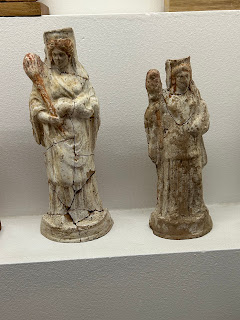Lipari, Italy is known for more than a cathedral and St. Bartholomew's thumb. Dan and I know there's a fabulous museum close by. Now, I like some museums and hate others and sometimes feel totally overwhelmed by the number of objects organized on shelves that you're forced to look at.
The Museum of Lipari is different.
Even though it is huge, it is housed in several different buildings, forcing you to make choices. It is primarily Greek artifacts unearthed centuries ago because Lipari was originally a Greek city. Dan and I (and Theo, reluctantly) decide to visit the Pre-historic museum building because it contains ruins unearthed outside the city walls from a Greek Necropolis (yes, a city of the dead). Beginning in 1948, archaeologists discovered 3000 tombs (so far) hidden under approximately thirteen feet of earth. These tombs and what was inside date back to four or five centuries before Christ. That's a long time ago.
Theo is slightly interested in two facts. One: the bodies were buried back then differently than the method we use today. No coffins. Instead, the remains were usually put into vase like structures that look more like wine canisters.
Two: the Greeks insisted on being buried with small objects that they believed helped them reach the afterlife.
The Greeks, back then, literally believed in the gods and the power they had to control the life of humans. One of the most popular was Bachus or Dionysus (his Roman name), son of Zeus, who was the god of wine, festivity, fruit, vegetation, fertility, theatre and religious ecstasy. For the Greeks, theatre was a religious experience.
Therefore, the tombs contained all sorts of neat little objects representing the person's belief in their preferred god, usually Dionysus.
Theo is fascinated. As we walk past shelves filled with all these tiny figurines--statues of people and animals or masks that connect to the theatre--Theo's paw keeps stretching out and hitting glass. He can see them, but he can't touch them. He can't sniff them which amounts to another excruciatingly depressing experience for the gangster cat. The hits become more frenetic.
"Stop that, Theo. Just look. You can't touch."
He gives me a woeful expression. Isn't that the story of my life, he seems to want to say.
"I think Theo has had enough," Dan says.
"You're right. I think it's time we go and visit Aldo."






















































